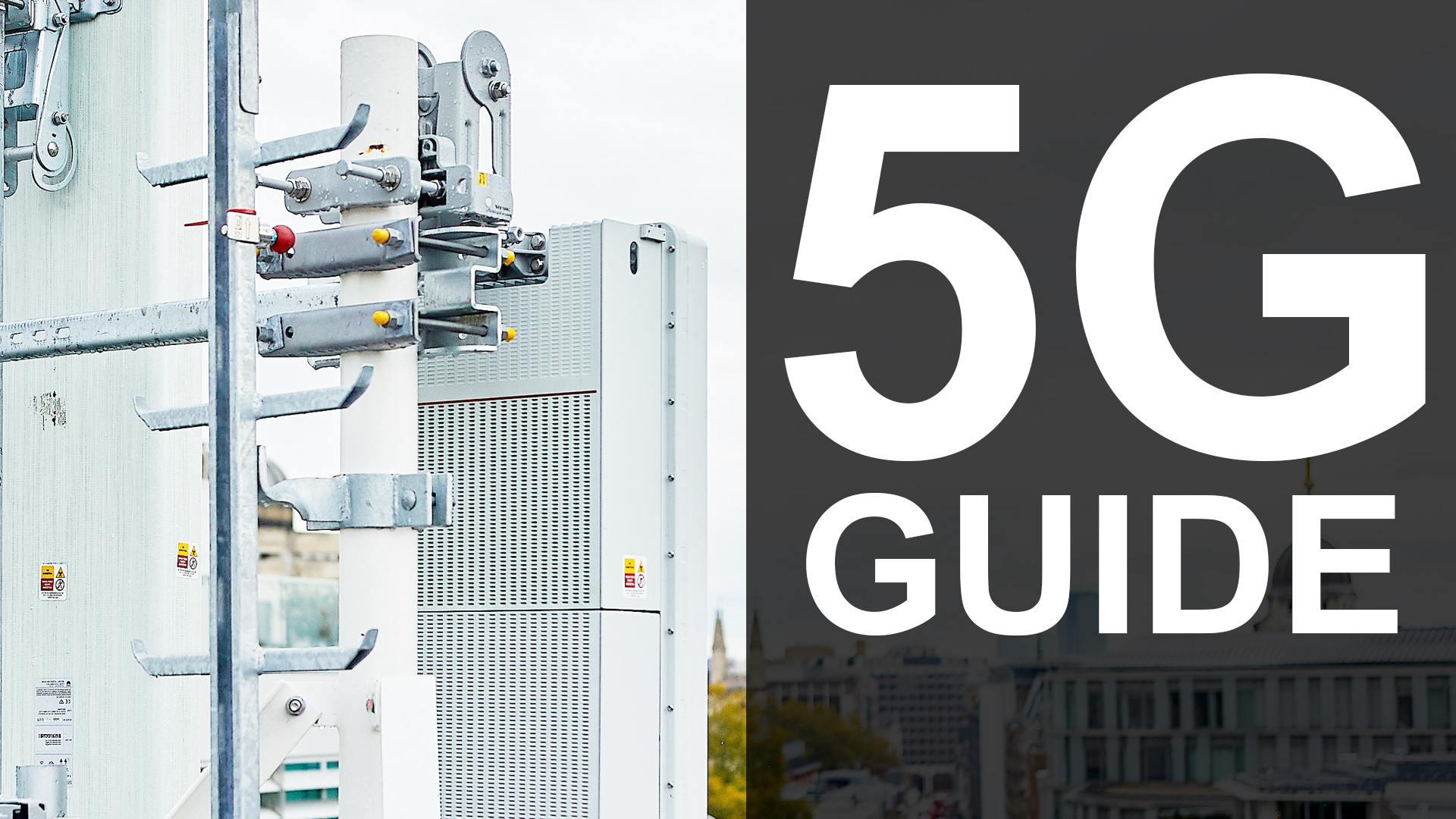5G Internet: is 5G broadband a viable alternative to fibre?
5G Internet could succeed, thanks to higher speed and greater reliability. Discover if it will it ever replace cable.


5G technology: how it works
4G vs 5G: how they compare
5G use cases: examples of 5G
5G Dangers: the fact and fiction
5G security: the full picture
5G speed: guide and tools
5G deals: get the best offers
5G phones: discover the best
5G networks: in the US and UK
5G stocks: investment tips
Broadband on 4G has established that there's a potential market for 5G broadband. And the idea that a mobile network could replace a fixed connection at home or in the office is now something that deserves serious consideration.
Before now a mobile broadband connection simply could not compete with fixed in terms of speed, while data restrictions have been a necessary measure to maintain overall quality for all users on the network.
This is where 5G comes in. The new generation of mobile technology brings with it many benefits, but chief among them is that speeds will rival and surpass the speeds of current fixed networks.
And that's exciting for bringing fast connections to all - including areas where it has so far been impossible to roll out fixed-line fibre broadband.
The potential of 5G internet
By 2024, Ericsson believes 5G networks will boast 1.9 billion subscribers, carry 35 percent of the world’s data traffic, and cover 65 percent of the global population. This creates a huge potential market for 5G broadband, which is viewed as one of the key new applications in the early years of 5G.
5G broadband will use a mixture of wireless spectrum (frequencies used to transmit television, radio and data signals).
Some of this spectrum will be low-band, which offers significant range but lower capacity, some will be high-band, which has the opposite characteristics, and some will be mid-band, which offers a balance between the two.
Get up to speed with 5G, and discover the latest deals, news, and insight!
Low-band spectrum will ensure widespread coverage, while mid-band and high-band frequencies boost the performance of 5G broadband to fibre-like performance levels and even higher. In the UK, regulator Ofcom has auctioned 3.4GHz airwaves, while US 5G networks are using high-band mmWave spectrum of 26GHz and above in their 5G technology.
UK regulator Ofcom is set to have a further auction next year, releasing a further 200MHz of bandwidth for 5G network services - specifically this equates to 80MHz worth of 700MHz and 120MHz of 3.6-2.8GHz spectrum.
Each UK network will be able to hold a maximum of 37 per cent of usable UK spectrum after the 2020 auction.
5G broadband speed
Trials of commercial 5G Fixed Wireless Access (FWA) networks using mmWave spectrum have achieved between 1-3Gbps, while analysts believe that consistent speeds of between 80 and100Mbps are achievable in a real world setting. Speed is no longer an issue.
Although fibre has significantly faster theoretical speeds, coverage is limited in markets like the UK. The overwhelming majority of superfast broadband in the UK is powered by Fibre to the Cabinet (FTTC), which uses copper for the final part of the connection, reducing speeds. Full fibre accounts for just three percent of the market.
This means that the average broadband speed in the UK is 46.2Mbps, while the number of urban users receiving less than 80Mbps is 85 percent. This is half the promised speed of 5G Internet.
Although BT, Virgin Media and others are expanding their Fibre to the Premise (FTTP) footprints, 5G FWA is cheaper to deploy than fibre because there is no need to dig up streets or for engineers to install equipment at a home or office. It will also take time for coverage to expand, with the government targeting nationwide coverage by 2033.
In short, 5G can deliver faster speeds, more quickly than fibre. And that's going to change things a great deal.
Nokia puts FWA in its top 5G use cases
In a report, focusing on 5G plans, expectations and the biggest 5G drivers for businesses in the US and UK, Nokia revealed the top five 5G use cases across a number of different industry sectors, with FWA being among them.
The study, titled ‘Mapping demand: The 5G opportunity in enterprise for communications service providers’, was conducted in partnership with Parks Associates, and surveyed over 1,000 IT decision-makers, covering key enterprise segments including energy, manufacturing, government/public safety, and automotive/transportation.
In the study, Nokia has outlined the following five 5G use cases as the key drivers in 5G adoption for enterprises, which illustrate the technology’s huge potential, from connected cars, to immersive learning environments. And 5G internet delivery was key.
Fixed wireless access, or FWA, is an appealing alternative to wired broadband for SMBs, and the Nokia report found that “fixed wireless access emerged from our survey as a strong near-term opportunity”. With 73% of SMBs surveyed saying that 5G FWA was appealing as an alternative or back-up to wired broadband.
“Encouragingly for CSPs, we found that most SMBs would prefer to get FWA from a mobile provider,” the report said. “However, 40% said they’d be open to receiving it from a tech giant like Google or Amazon, with others citing TV, utilities and security systems providers. To compete, CSPs should emphasize strengths like expert support and an existing technical field force. Alternatively, other providers may present MVNO partnership opportunities.”
What services are available?
5G stands to succeed where other attempts to establish a wireless broadband standard, such as WiMax, have failed.
Because 5G broadband is based on the same standards as 5G, it already has widespread support from operators and equipment manufacturers. In that sense, it's not forging a new path but one that's been accepted for several years.
Operators are more excited about 5G broadband than they were with 4G. The additional capacity and lower cost-per-bit of transmission means they can market FWA as a genuine fibre replacement and open up additional revenue streams that maximise their infrastructure investments.
In the UK, all of the networks now have a 5G service to some degree. In terms of 5G broadband though, the choice is limited.
Since autumn 2019, Three has offered Three 5G FWA services to parts of central London. It is quite difficult to identify just where Three is offering the service - many central London postcodes we have tried on Three's site don't offer 5G home broadband, just 4G.
However, Three isn't rolling out this service elsewhere at present. It's planning on concentrating on its early 2020 roll out of 5G phone services before taking the mobile broadband offering to other locations outside of the capital. For more information on this, check out our complete guide to Three 5G.
The Three service uses Huawei's 5G CPE Pro router - it's plug-and-play with next-day delivery.
Vodafone is also offering 5G broadband with the Huawei CPE Pro router, which offers wired internet ports as well as wireless access. It's not restricted by location as Three's service is, but of course it's only going to work in 5G areas.
Vodafone is also marketing a combined 5G home broadband and phone service. Called Vodafone Together, this will give you a single bill.
For EE, 5G broadband is firmly on the agenda, and customers can now take advantage of the 5G EE Home Router.
O2 hasn't yet talked about a 5G broadband offering.

Halo for Business includes an always-connected guarantee and customers can add 4G and 5G mobile connections. Businesses can make and receive calls on their landline number straight from a mobile, so you needn’t worry about missing an important call (read the full story on BT Halo here).
In the US, 5G Internet was the focus for AT&T and Verizon, with both launching their respective Verizon 5G and AT&T 5G services in late 2018.
Both are using mmWave spectrum to provide broadband services to major cities, many of which are served by a single cable operator, reducing competition.
Verizon 5G Home Internet is available in many key US cities and will also be coming to more locations, too, although this extended rollout has now been delayed until later in 2020.
Verizon is instead working on improving its coverage in the urban areas where it has deployed 5G mmWave-based services already. Verizon 5G Home Internet is being offered in very limited areas for now.
Verizon provides its own 5G router, made by Wistron. The network is offering the Inseego 5G Mi-Fi M1000 hotspot to bring 5G services to other devices.
Ronan Dunne - executive vice president of Verizon's consumer business - stated that Verizon's 5G Home target is to cover 30 million US households within 5-7 years.
The flexibility of 5G broadband
For residential or home office users, there’s a realistic case to be made for adoption. Ovum says the average UK household currently consumes 190GB a month – a figure that will increase to 516GB by 2023 thanks to the popularity of video streaming services, online gaming, and other applications.
The imposition of data limits on 4G broadband meant it was an impractical alternative to fixed. The abolition of data limits with 5G makes FWA a feasible option.
Ofcom estimates there are 860,000 premises in the UK with broadband speeds lower than 10Mbps. If 5G Internet is available in such an area, then it makes sense for a small business to cut the cord and benefit from significantly faster speeds. For those areas where it hasn't been financially viable to introduce fibre broadband, 5G connectivity could really change the level of connectivity available to communities.
But even in areas served by superfast broadband, 5G broadband can be transformative. Businesses in shared office facilities or business parks might only have one choice of provider – the one selected by the owner of the building. Meanwhile, startups in co-working spaces have to rely on a common Wi-Fi network. 5G broadband gives more freedom and superior connectivity.
5G broadband is also more flexible than fixed and so can be placed anywhere. Equipment is ‘plug-and-play’ so there is no need to wait for an operator to lay cables or for an engineer to complete an installation. Businesses can get up and running more quickly.
The gear can also be placed anywhere within a home or business - the router doesn't need to be placed in a position near the socket. This should improve signal and range through better placement.
This is significant for organisations that have branch offices, or industries like construction where staff are often located in areas with no fixed connectivity for relatively short periods of time. Flexibility is also a significant asset during an office move as businesses just take their equipment with them. There’s no need to contact a provider and wait for a new installation.
Is 5G broadband suitable for large businesses?
In a word, no. 5G FWA is unlikely to be an option for larger businesses with bigger workforces. Enterprises generally have access to dedicated Ethernet connections that provide the speed and capacity required to power employee devices and mission critical applications.
SMBs should also consider the fact that the wider availability of full fibre in the future years means 5G will lose any speed advantage in currently under-served areas. And in countries where FTTP is widespread, the speed argument is negligible.
We don't yet know where the cut-off might be that would make 5G a better proposition than fibre, predominantly because we don't really know how consistent and reliable 5G internet connections will be compared to fibre. Of course, it'll also depend on where you are - and so when you can get access to 5G. If your business is in rural Scotland, you might not be able to get on board with 5G broadband for a while even if you wanted to and had a relatively small business.
It also depends whether 5G broadband has usage limits imposed - these could be prohibitive for some businesses depending on what line of work they're in. It's likely that we'll see unlimited packages given what's already happened in 5G phones. But will these come at a cost that's actually too prohibitive?
Naturally, for those businesses in areas with slow fixed line broadband, 5G broadband could seem like a godsend if access is more plentiful - which will surely open up new business opportunities for some. It'll also help larger businesses that are currently restricted because of their connectivity options.

Three CEO Dave Dyson, one of the biggest proponents of 5G broadband, admits that speed will eventually become less of a pain point, but says his firm isn’t targeting power users.
“We’re not looking for 100 per cent market share, we just need the market to be big enough,” he says. “[5G FWA] technology is complementary [to fibre],” he says. “To get the UK fully fibred up is going to take a decade. If you want to get ultrafast broadband as fast as possible, you can do it quickly and more cost effectively [with 5G FWA].”
But even coverage will be an issue. Although rollout is likely to be rapid, it will take time for 5G to become widespread as operators invest in their infrastructure. Huawei, for example, believes it won’t be until 2027 before the majority of the UK has access to 5G.
The inevitable focus on deployment will be on urban areas, meaning that rural areas that stand to benefit the most from 5G broadband will have to wait for the network to come to them.
The role of convergence and Wi-Fi 6
However, one area where 5G will likely play a role in the enterprise space is convergence.
While previous generations of Wi-Fi have had complicated, technical names like 802.11ac, the next generation of Wi-Fi will be known as ‘Wi-Fi 6’. This mimicking of mobile’s nomenclature is deliberate, with the wireless industry positioning Wi-Fi 6 as a complementary technology to 5G.
In addition to faster speeds, Wi-Fi 6 lowers latency, increases capacity and significantly improves battery life. These characteristics will support converged networking services in which the lines between fixed, wireless and mobile are blurred, with the most optimum networking technology used to transmit data.
Widespread vendor support and interoperability will see Wi-Fi 6 become a fixture of networking equipment and 5G handsets.
This combination of technologies demonstrates the increasingly blurred lines between different networking technologies. In the future, business won’t care which standard is used to connect people, applications, and things just so long as they are connected.
5G’s role in this is to break down the historical disadvantages of cellular connectivity. FWA currently accounts for just two percent of the global market, but Analysys Mason suggests the market opportunity with 5G is between 20-30 percent, or 290 million addressable premises.
5G Internet is a genuine alternative for small businesses, branch offices and rural organisations but in areas where FTTP is available or flexibility isn’t as prized, then this appeal is reduced.
Fibre will remain the predominant form of communication for the majority of businesses, but 5G and converged services will play a vital role in the era of ubiquitous connectivity.
- Discover the best 5G networks in the UK and US
- Get your hands on the hottest 5G phones
- Millimeter wave: the secret sauce behind 5G
- The complete guide to 5G security
- We reveal the latest 5G use cases
- Discover the truth behind 5G dangers
- 5G towers: everything you need to know
Steve McCaskill is a former editor of Silicon UK, and is an experienced journalist. Over the last eight years Steve has written about technology, in particular, telecoms, mobile, sports tech, video games and media.

